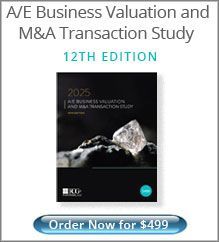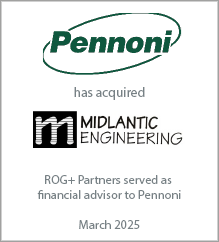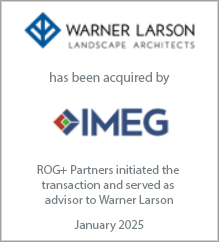Michael S. O'Brien is a principal in the Washington, DC office of Rusk O'Brien Gido + Partners. He specializes in corporate financial advisory services including business valuation, fairness and solvency opinions, mergers and acquisitions, internal ownership transition consulting, ESOPs, and strategic planning. Michael has consulted hundreds of architecture, engineering, environmental and construction companies across the U.S. and abroad.
Will M&A Drive Value in 2025?
January 15, 2025
Understanding Value
The value of a business is fundamentally defined as its expected future cash flow, discounted to their present using a risk-adjusted rate of return. As we look toward 2025 and how A/E firms’ values may change, it’s crucial to consider what these cash flows will look like and the risks associated with not achieving them.
Rates of Return in a Volatile Environment
Determining the appropriate rate of return in a fluctuating interest rate landscape poses challenges. Interest rates significantly influence both cash flow and valuation. Contrary to common belief, the capital market (public companies) is largely influenced by the debt market. To forecast 2025 effectively, one must analyze how policies, economic conditions, and interest rates will shape business prospects.
On March 17, 2022, the Federal Reserve raised the overnight rate by 25 basis points (BPS) and continued to raise it ten more times, totaling 500 BPS. However, since September 24, 2024, the Fed has reduced the overnight rate by 100 BPS. Notably, while the prime lending rate followed this decrease, the yield on the ten-year Treasury bond increased by 104 BPS during the same period.
This phenomenon can be attributed to quantitative tightening (QT), where the Fed sells off its assets, including U.S. Treasuries and mortgage-backed securities (MBS). During the COVID-19 pandemic, the Fed purchased over $4 trillion in these assets to ensure market liquidity, a strategy known as quantitative easing (QE). Initially introduced during the Great Recession, QE drove the ten-year Treasury rate and mortgage rates to historic lows in 2021—0.449% and 2.65%, respectively. As the Fed raised the benchmark overnight rate, it also initiated QT, leading to an excess supply of debt securities exceeding demand, which increased yields for Treasuries and MBS. Consequently, the cost of capital and mortgage loan rates have risen, with the current ten-year Treasury rate at 4.77% and MBS yielding 6.93%.
The Relationship Between Interest Rates and Valuation
As interest rates rise, valuations typically decline because the anticipated future cash flows decrease, primarily due to increased operating costs. This creates downward pressure on valuations, particularly when considering the cost of capital alone.
However, there are several positive factors that we expect will mitigate this downward pressure:
- Infrastructure Investment and Jobs Act (IIJA):
The benefits from the IIJA are still unfolding, providing significant funding for infrastructure projects that can enhance revenue opportunities for firms in the sector.
- Robust M&A Activity:
M&A activity is increasingly being fueled by private equity (PE) firms that are becoming more comfortable investing in the professional services sector, despite the limited intellectual property advantages typically found in other sectors. PE firms are particularly drawn to the architecture and engineering (A/E) industry due to their substantial cash reserves, often referred to as "dry powder," which have made it challenging to identify attractive investment opportunities.
This surge in M&A activity is likely to maintain valuations above internal assessments, primarily driven by a talent shortage that is driving up the costs of hiring. We are witnessing market conditions reminiscent of the period leading up to the Great Recession, where the expenses associated with hiring talent have surpassed the costs of acquiring entire firms.
In the past year, it has become increasingly common for firms to pay full price for companies with special status designations (such as Minority Business Enterprises (MBE), Women Business Enterprises (WBE), and Small Business Enterprises (SBE). This willingness stems from the high demand for qualified employees, which outweighs the potential risks associated with losing special status projects. - Political Changes:
Donald Trump's recent re-election for a second term is poised to impact the architecture and engineering (A/E) industry significantly. His administration is expected to focus on reducing regulatory burdens, which could lower production costs and potentially enhance consumer purchasing power. A critical aspect of this agenda will be the extension or permanent continuation of the business tax cuts enacted in 2018.
However, a Trump administration brings with it a mix of possibilities and uncertainties. The potential expansion of tax cuts, the imposition of tariffs on goods, and the escalating federal deficit present challenges that could affect market dynamics. Despite these uncertainties, many firms are expressing renewed optimism regarding economic activity under the new administration. They anticipate that the federal government may ease its regulatory oversight, allowing companies greater flexibility in their operations.
Conclusion
In summary, M&A activity continues to be strong because of the revenue visibility from IIAJ, a potentially more favorable business climate (less regulation), and large amounts of “dry powder” held by private equity seeking limited investment opportunities. In combination, these factors will likely keep valuations on a firmer footing through at least 2025.








